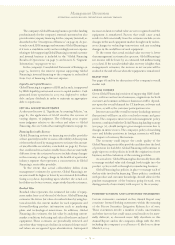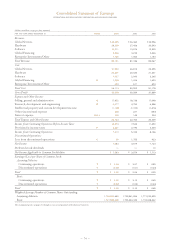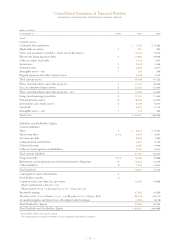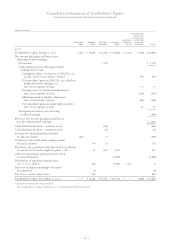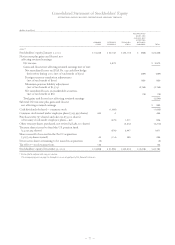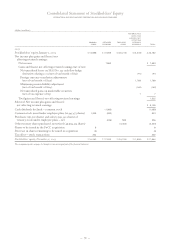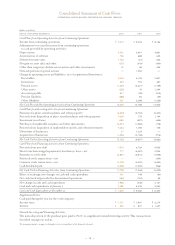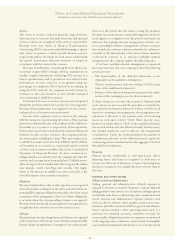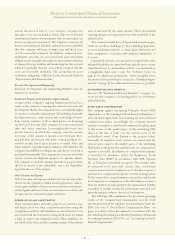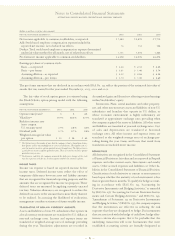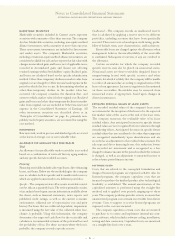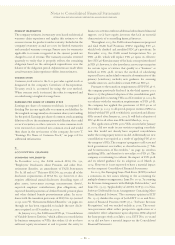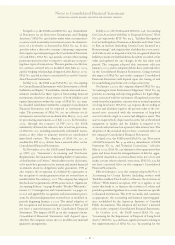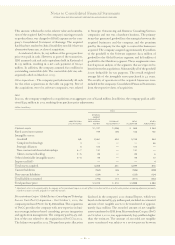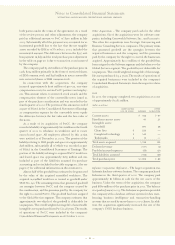IBM 2003 Annual Report Download - page 83
Download and view the complete annual report
Please find page 83 of the 2003 IBM annual report below. You can navigate through the pages in the report by either clicking on the pages listed below, or by using the keyword search tool below to find specific information within the annual report.
Services
The terms of services contracts generally range from less
than one year to ten years. Revenue from time and material
services contracts is recognized as the services are provided.
Revenue from data center or Business Transformation
Outsourcing (BTO) contracts in which IBM manages a client’s
data center or operates a client’s specific business process,
respectively, reflects the extent of actual services delivered in
the period, based upon objective measures of output in
accordance with the terms of the contract.
Revenue from Business Consulting Services (BCS) con-
tracts that require IBM to design, develop, manufacture or
modify complex information technology (IT) systems to a
buyer’s specifications, and to provide services related to the
performance of such contracts, is recognized using the
percentage of completion (POC) method of accounting. In
using the POC method, the company records revenue by
reference to the costs incurred to date and the estimated
costs remaining to fulfill the contracts.
Provisions for losses on services contracts are recognized
during the period in which the loss first becomes apparent.
Revenue from maintenance is recognized over the contrac-
tual period or as the services are performed.
In some of the company’s services contracts, the company
bills the client prior to performing the services. This situation
gives rise to deferred income of $3.3 billion and $2.6 billion at
December 31, 2003 and 2002, respectively, and is reported as
Deferred income in the Consolidated Statement of Financial
Position. In other services contracts, the company performs
the services prior to billing the client. This situation gives rise
to unbilled accounts receivable of $1.8 billion and $1.3 billion
at December 31, 2003 and 2002, respectively, and is recorded
as Notes and accounts receivable-trade in the Consolidated
Statement of Financial Position. In these circumstances,
billings usually occur shortly after the company performs the
services and can range up to six months later. Unbilled receiv-
ables are expected to be billed and collected generally within
four months, rarely exceeding nine months. The largest
driver of the increase in unbilled accounts receivable is the
favorable impacts from currency translation.
Hardware
Revenue from hardware sales or sales-type leases is recognized
when the product is shipped to the client and when there are
no unfulfilled company obligations that affect the client’s final
acceptance of the arrangement. Any cost of these obligations
is accrued when the corresponding revenue is recognized.
Revenue from rentals and operating leases is recognized on a
straight-line basis over the term of the rental or lease.
Software
Revenue from one-time charge licensed software is recognized
at the inception of the license term. Revenue from monthly
license charge arrangements is recognized on a subscription
basis over the period that the client is using the program.
Revenue from maintenance, unspecified upgrades and tech-
nical support is recognized over the period such items are
delivered. For multiple-element arrangement software con-
racts and multiple-element arrangement software contracts
that include non-software elements whereby the software is
essential to the functionality of the non-software elements
(collectively referred to as software multiple-element
arrangements), the company applies the following rules:
Asoftware multiple-element arrangement is separated
into more than one unit of accounting if all of the following
criteria are met:
•The functionality of the delivered element(s) is not
dependent on the undelivered element(s).
•There is vendor-specific objective evidence (VSOE) of fair
value of the undelivered element(s).
•Delivery of the delivered element(s) represents the culmi-
nation of the earnings process for those element(s).
If these criteria are not met, the revenue is deferred until
such criteria are met or until the period(s) over which the
last undelivered element is delivered. If there is VSOE for all
units of accounting in an arrangement, the arrangement con-
sideration is allocated to the separate units of accounting
based on each unit’s relative VSOE. There may be cases,
however, in which there is VSOE of the undelivered item(s)
but no such evidence for the delivered item(s). In these cases,
the residual method is used to allocate the arrangement
consideration. Under the residual method, the amount of
consideration allocated to the delivered item(s) equals the
total arrangement consideration less the aggregate VSOE of
the undelivered elements.
Financing
Finance income attributable to sales-type leases, direct
financing leases and loans is recognized at level rates of
return over the term of the leases or loans. Operating lease
income is recognized on a straight-line basis over the term of
the lease.
EXPENSE AND OTHER INCOME
Selling, General and Administrative
Selling, general and administrative (SG&A) expense is
charged to income as incurred. Expenses of promoting and
selling products and services are classified as selling expense
and include such items as advertising, sales commissions and
travel. General and administrative expense includes such
items as officers’ salaries, office supplies, non-income taxes,
insurance and office rental. In addition, general and adminis-
trative expense includes other operating items such as a
provision for doubtful accounts, workforce accruals for
contractually obligated payments to employees terminated
in the ongoing course of business, amortization of intangible
assets and environmental remediation costs. Certain special
Notes to Consolidated Financial Statements
INTERNATIONAL BUSINESS MACHINES CORPORATION AND SUBSIDIARY COMPANIES
81




